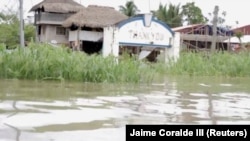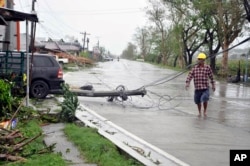A poor region of the Philippines is struggling to recover from an odd New Year’s weekend tropical storm that killed at least 85 people and caused extensive damage.
Tropical storm Usman flooded villages and set off landslides after reaching the archipelago’s Pacific Ocean coasts Dec. 29. According to Philippine Red Cross estimates, more than 128,000 people were affected by flooding and about 15,000 people still need aid.
The Philippines suffered a number of typhoons earlier in the year but was caught off guard because weather maps tracked Usman as a tropical depression rather than a full-blown typhoon. It also weakened after initial landfall. But its heavy rainfall lingered over the peninsula southeast of Manila long enough to cause slides and flooding.
“You never, never sleep well when there’s an unusual rain now, and climate change is proving itself, so we won’t take it for granted,” said Richard Gordon, a senator and chairman of the Philippine Red Cross.
About one-third of those killed were drowned, Gordon said. Landslides buried the houses of some victims, Gordon added.
“Government should start building houses in safe areas,” he said.
Relief work bares extent of losses
The Philippine Red Cross is working with government agencies on searches, rescues and first aid, the agency said in an activity summary Monday. It has already helped about 28,000 people find temporary shelters and allowed some to return home.
People affected by floods or landslides most urgently need drinking water, of which the Red Cross has brought in six tankers, as well as food and basics such as toothbrushes, Gordon said. He described the regions hit as poor and noted that some families might have lacked “creature comforts” even before the storm. About 300 families were living in 24 evacuation shelters as of late Thursday.
Relief work, initially slow because volunteers were hard to find on a rainy New Year’s Eve and the hardest-hit areas were at least two hours from the nearest major city, is now exposing “extensive” infrastructure damage, Gordon said.
On Wednesday and Thursday, Philippine Vice President Leni Robredo met the families of people who died in the province of Camarines Sur. Robredo’s office said in a statement it had given cash aid to 16 families Wednesday and to relatives of 12 other deceased people a day later plus 800 “relief packs.”
Freakish late-year storm
Typhoons and tropical storms regularly hit the Philippines, but their season normally tapers off in November. One of the country’s worst, Typhoon Haiyan, killed more than 6,000 in November 2013.
The country’s most powerful storm of 2018 killed 81 people in the rugged mountains north of Manila in September. That storm, called Mankhut, also raised questions about the extent of home construction in storm-prone zones.
“I think there was a miscalculation on the damage,” Gordon said in a statement Thursday on the latest storm. “Usman was not as strong, but it brought a lot of rains. It is important that we become a little bit more aggressive and make sure that we respect any kind of tropical depression.”
But the hardest-hit areas normally get their most rainfall around December, said Jim Andrews, meteorologist with the AccuWeather.com forecasting service in the United States. Tropical storms can easily form in East Asia even after November, he noted, and another one is pressing toward southern Thailand now.
Seasonally cold air from the north made Usman look weak on radar maps, said David Michael Padua, senior typhoon specialist with the Manila-based forecasting service Weather Philippines Foundation.
“The system was being blown down by the strong surge of the northeast monsoon,” Padua said in an online broadcast Dec. 30. “These are cold dry airs, which weaken the system, especially in cold months, like in December.”
Longer-term damage
Usman will probably set back farming, add to inflation and slow economic activity for a month before reconstruction gets underway, said Rahul Bajoria,a regional economist with Barclays in Singapore.
Bridges will need repairs, Gordon said, and cropland is ruined. Crop damage is estimated at $3.7 million, domestic media reports say.
But given the frequency of severe storms at other times of year, agencies in the Philippines know how to recover quickly, Bajoria said.
“It’s been a bad year for disasters this year for the Philippines, especially in the last three, four months, so it will have some temporary negative impact I think on activity,” he said. “Broadly I think the country is quite prone to getting hit by natural disasters, so it typically does not tend to have a huge negative impact.”









